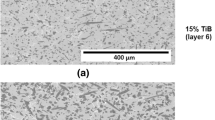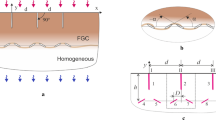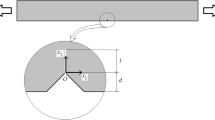Abstract
An edge crack in a strip of functionally gradient ceramics (FGC) is studied under thermal loading conditions. Two FGC materials are considered, i.e., one with a spatial variation of shear modulus and the other with a spatial variation of thermal conductivity. Thermal stress intensity factors (TSIF) are numerically calculated based on singular integral equations derived for the dislocation density along the crack faces. It is shown that: (a) for the FGC with a graded shear modulus, the TSIF are reduced for crack lengths longer thanl c b and remain approximately the same as those of a homogeneous material for shorter crack lengths, wherel c is about 0.065 andb is the width of the strip; and (b) for the FGC with a thermal conductivity gradient, the TSIF are generally lower compared with those for the bonded two-layer material.
Similar content being viewed by others
References
M. Koizumi,The Concept of FGM. InCeramic Transactions, Vol. 34: Functionally Gradient Materials, ed. by J. B. Holt et al., American Ceramic Society, Westerville, Ohio 1993, pp. 3–10.
D. P. H. Hasselman and G. E. Youngblood,Enhanced thermal stress resistance of structural ceramics with thermal conductivity gradient, J. Am. Ceram. Soc.61, 49 (1978).
K. Satyamurthy, D. P. H. Hasselman, J. P. Singh and M. P. Kamat, Effect of spatial variation of thermal conductivity on magnitude of tensile thermal stresses in brittle materials subjected to convective heating. InThermal Stresses in Severe Environments, ed. D. P. H. Hasselman and R. A. Heller. Plenum Press, New York 1990, pp. 325–342.
N. Noda and T. Tsuji,Steady thermal stresses in a plate of a functionally gradient material. InProc. 1st Int. Symp. on Functionally Gradient Materials, ed. by M. Yamanouchi, M. Koizumi, T. Hirai and I. Shiota, Sendai, Japan 1990, pp. 339–344.
Y. Arai, H. Kobayashi and T. Tamura,Elastic-plastic thermal stress analysis for optimum design of FGM. InProc. 4th National Symp. on Functionally Gradient Materials (FGM'91), Functionally Gradient Materials Forum, Kawasaki, Japan 1991, pp. 19–30.
J. T. Drake, R. L. Williamson and B. H. Rabin,Finite element analysis of thermal residual stresses at graded ceramic-metal interfaces, Part II: Interface optimization for residual stress reduction, J. Appl. Phys.74, 1321–1326 (1993).
Proceedings, 1st Int. Symp. on Functionally Gradient Materials, ed. by M. Yamanouchi, M. Koizumi, T. Hirai and I. Shiota, Sendai, Japan 1990.
Proceedings, FGM'91–93, Functionally Gradient Materials Forum, Tokyo, Japan.
A. Kawasaki and R. Watanabe,Thermal shock fracture mechanism of metal-ceramic functionally gradient materials. InThermal Shock and Thermal Fatigue Behaviour of Advanced Ceramics, ed. by G. A. Schneider and G. Petzow, Kluwer Academic Publ., Dordrecht 1993, pp. 509–520.
H. Takahashi, T. Ishikawa, D. Okugawa and T. Hashida,Laser and plasma-ARC thermal shock/fatigue fracture evaluation procedure for functionally gradient materials. InThermal Shock and Thermal Fatigue Behaviour of Advanced Ceramics, ed. by G. A. Schneider and G. Petzow, Kluwer Academic Publ., Dordrecht 1993, pp. 543–554.
C. Atkinson and R. D. List,Steady state crack propagation into media with spatially varying elastic properties, Int. J. Engng Sci.16, 717–730 (1978).
R. S. Dhaliwal and B. M. Singh,On the theory of elasticity of a non-homogeneous medium, J. Elasticity8, 211–219 (1978).
F. Delale and F. Erdogan, The crack problem for a nonhomogeneous plane, ASME J. Appl. Mech.50, 609–614 (1983).
Z.-H. Jin and N. Noda,An internal crack parallel to the boundary of a nonhomogeneous half plane under thermal loading, Int. J. Engng Sci.31, 793–806 (1993).
N. Noda and Z.-H. Jin,Thermal stress intensity factors for a crack in a strip of a functionally gradient material, Int. J. Solids Struct.30, 1039–1056 (1993).
F. Erdogan and B. H. Wu,Analysis of FGM specimens for fracture toughness testing. InCeramic Transactions, Vol. 34: Functionally Gradient Materials, ed. by J. B. Holt et al. American Ceramic Society, Westerville, Ohio 1993, pp. 39–46.
Z.-H. Jin and N. Noda,Transient thermal stress intensity factors for a crack in a semi-infinite plane of a functionally gradient material, Int. J. Solids Struct.31, 203–218 (1994).
Z.-H. Jin and N. Noda,Crack-tip singular fields in nonhomogeneous materials, ASME J. Appl. Mech.61, 738–740 (1994).
The CRC Materials Science and Engineering Handbook, eds. J. F. Shackelford and W. Alexander, CRC Press, Boca Raton, FL 1992.
R. Warren,Overview, in Ceramic-Matrix Composites, ed. R. Warren, Blackie, Glasgow 1992.
J. C. Smith,Simplification of van der Poel's formula for the shear modulus of a particulale composite, J. Research Natl. Bureau of Standards-A. Physics & Chemistry79A, 419–423 (1975).
R. M. Christensen and K. H. Lo,Solutions for effective shear properties in three phase sphere and cylinder models, J. Mech. Phys. Solids27, 315–330 (1979).
N. I. Muskhelishvili,Singular integral equations, Noordhoff, Groningen 1953.
G. D. Gupta and F. Erdogan,The problem of edge cracks in an infinite strip, ASME J. Appl. Mech.41, 1001–1006 (1974).
A. C. Kaya and F. Erdogan,On the solution of integral equations with strongly singular kernels, Quart Appl. Math.45, 105–122 (1987).
A. F. Emery, G. E. Walker, Jr. and J. A. Williams,A Green's function for the stress intensity factors of edge cracks and its application to thermal stresses, ASME J. Basic Engng91, 618–624 (1969).
H. F. Nied,Thermal shock fracture in edge-cracked plate, J. Thermal Stresses6, 217–219 (1983).
A. E.-F. A. Rizk and S. F. Radwan,Fracture of a plate under transient thermal stress, J. Thermal Stresses16, 79–102 (1993).
X. R. Wu,Application of weight function method for crack analysis in thermal stress fields. InThermal Shock and Thermal Fatigue Behaviour of Advanced Ceramics, ed. by G. A. Schneider and G. Petzow, Kluwer Academic Publ., Dordrecht 1993, pp. 119–141.
Z. Hashin and S. Shtrikman,A variational approach to the theory of the effective magnetic permeability of multiphase materials, J. Appl. Phys.33, 3125 (1962).
R. M. Christensen,Mechanics of Composite Materials, John Wiley & Sons, New York 1979.
Author information
Authors and Affiliations
Rights and permissions
About this article
Cite this article
Jin, Z.H., Mai, Y.W. Thermal fracture of functionally gradient ceramics. Z. angew. Math. Phys. 47, 467–484 (1996). https://doi.org/10.1007/BF00916650
Received:
Issue Date:
DOI: https://doi.org/10.1007/BF00916650




